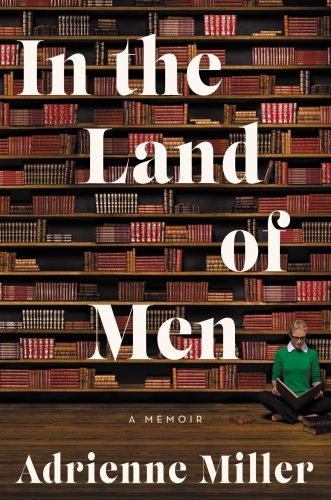Book Review: “In the Land of Men” — A Woman in the Boy’s Club of Glossy Magazines
By Matt Hanson
A victim Adrienne Miller is most certainly not: the self-portrait that emerges in her pages is of an accomplished, wise, wittily self-deprecating author of her own destiny.
In the Land of Men by Adrienne Miller. Harper Collins, 352 pages, $28.99.

Straight out of college in the mid-’90s, and at the impressive age of 22, Adrienne Miller became an assistant editor at GQ magazine, and eventually the fiction editor at Esquire, back in the days when the magazine industry was much more confident than it is now. Her self-description sounds at times like a character out of a sitcom: a bookish, witty Midwesterner hailing from a small rust belt town in Ohio, thrilled to have landed a plum literary gig in the Big Apple. When her anxious parents send her food money, she instead arms herself for her new job with a new handbag and expensive shoes. Even though the dust jacket calls Miller “naïve and idealistic,” her engaging new memoir In The Land of Men quickly pops those clichés like balloons with a prick of her pen.
Sure, on the surface she’s a fresh-faced Midwestern gal on the loose in the very masculine (read: self-absorbed and self-aggrandizing) world of publishing. But a victim she is most certainly not: the self-portrait that emerges in her pages is of an accomplished, wise, wittily self-deprecating author of her own destiny. She’s much more like a spunky ’90’s version of self-reliant Isabel Archer or Lizzie Bennet than some helpless naïf lost in the big city.
Understanding how unlikely her big break might seem, Miller explains why she was chosen among the many often highly qualified applicants for the GQ position. And it is good advice for anyone who wants to write seriously: whatever your level of knowledge or experience, know thy subject. Miller recalls her undergraduate fascination with GQ; she obsessively studied countless back issues instead of doing classwork. Her detailed knowledge of the ins and outs of various GQ back issues actually put her miles head of the often arrogant and CV-obsessed competition, many of whom had never even bothered to actually read the magazine before applying.
Miller knew her stuff, had a knack for editing, and an almost religious belief in the pursuit of artistic excellence. She describes how watching Amadeus at the prodigious age of 13 inspired her to read everything by Peter Schaffer, who wrote the original play, and to bask in Mozart’s music. Miller is charmingly modest (Midwestern to the core) about her born writer’s ability to size up a situation and the sly insight that accompanies her wit, but she was clearly much wiser than she often gave herself credit for as she toured through the hallowed halls of a legendary but notoriously male-dominated literary world.
Miller can summon a whole scene or a person in a few well-chosen words. Art Granger, GQ’s editor in chief, is sketched briefly but potently: “A midcentury boulevardier with sensibilities entirely unbuttressed by irony, Art adored Frank, Dean, Sammy, and the Great American Songbook; in his office, he smoked miraculous qualities of cigarettes; he enjoyed multiple lunchtime and non-lunchtime martinis.… Art was wearing a chalk-striped suit with peak lapels. His beard was sparse, and he was rotund like a king who feasts on foie gras during times of famine.”
The scene where she is awkwardly propositioned for a date in her first hours on the job by the guy who fixes the copier is cringeworthy in its nervous authenticity. Miller’s editorial status doesn’t register to most of the often highly literate and accomplished men she works with — they’re both more and less interested by the mere presence of a female. Miller is perfectly aware of this at all times but, crucially, she never allows that male condescension and incomprehension to define or overwhelm her.
Even though Miller’s accomplished and competent, that didn’t mean she avoided being groped, assaulted, kissed, and fondled without consent, patronized, blatantly ignored, sucked up to, and reminded in both large and small ways that she was a woman in the boy’s club of glossy magazines. Miller shares these stories fully and frankly but without a hint of self-recrimination or victimization. Her narrative voice is fun to read and has a light touch. But there is a toughness as well — this is a confident woman who is determined to make it on her own terms. It’s not hard to see where the deep natural talent for writing comes from; the same wellspring of critical intelligence and perceptiveness that makes her an ace editor in the first place.
Interestingly, her memoir takes a sharp and complicating turn once she meets and starts editing David Foster Wallace. In some sense, her recounting of her personal and professional relationship with the legendary author undercuts the idea that this is her story — Wallace is an enormous presence in the book, which is most welcome for a fan like me, but could conceivably be grating for those uninterested in hearing what it was like to match wits with the alternately gentle, arrogant, courtly, manipulative, painstakingly earnest, and unstably emotional Wallace.
Miller submits a skimmed-over review of Infinite Jest in Esquire shortly after its first release (which, given its massive bulk and intricacy, is totally understandable), but quickly finds herself taken by Wallace’s capacious mind, incandescent talent, and commitment to the craft. A lesser person and weaker editor, one senses, would have let Wallace run circles around them with his evidently deep natural talent for digressions, logical paradoxes, and meta-cognition. But Miller winningly more than holds her own. Wallace is taken by her as well, opens up to her in ways that could either seem invitingly vulnerable or unsettlingly desperate, and the two have a relationship that overlaps personal and professional lives in lively ways that both people seem to thrive on.

Adrienne Miller — an ace editor. Photo: Greg Martin.
It’s a marriage of true minds facilitated by epic long distance phone calls on both sides — which can be trying when Wallace is in one of his needy, insecure moods — but Miller finds that she misses them whenever there’s a pause in communication. Early on the deeply troubled Wallace confesses, with apparent sincerity, that he feels more capable of opening up to her than he has with almost anyone else. Miller is usually happy to be there for him, and readily admits that she loves him. She’s also able to see through his various gambits for emotional control and manipulation, which is crucial. The fact that she can speak on equal terms with Wallace and hold her own is a turn-on for both of them. When Wallace tells her that he’s found the right adjective for her, she’s touched in a way that only a fellow writer can be, and one look at her author picture shows that he got at least this much right.
But Wallace has demons that even he cannot admit to, despite his brilliant skills with language. Bookish people can be a pretty weird bunch, but it’s not every day that someone brings up Durkheim’s book-length treatise on suicide during the getting-to-know-you phase. Considering how Wallace met his end, some of his behavior reinforces the old saying that when someone tells you who they are, believe them. Wallace toyed with dedicating his collection of short fiction Brief Interviews with Hideous Men to Miller, which tells you something about their relationship. Miller was both impressed and shocked with what she read in it, which tells you something else. Mary Karr probably had an even messier time when she dated Wallace long before Miller did. In recent years there has been an uproar over the revelations of how ugly Wallace’s pre-sobriety behavior could become. Karr is a tough cookie — as shown in her superb memoir The Liar’s Club — and she has indicated that her disclosures have inspired a bit more umbrage than necessary, which is significant because she was the one who actually lived through it.
They say that you should never meet your heroes in person, or you’ll come away disappointed; Orwell once argued that any biography that doesn’t disclose something embarrassing about its subject is not to be trusted. I tend to feel reassured whenever it’s shown that the Great (usually Male) Artists can be just as fucked-up, petulant, and immature as the rest of us, especially during situations that bring out the worst in us. At some points, the reader might wonder if Miller’s telling the story of her complex relationship with Wallace ends up elbowing aside Miller’s other adventures in literary-land. Miller has a purpose: to use the story of her life with Wallace to gesture toward the gradual demise of magazine publishing, which for various reasons couldn’t sustain itself by putting out adventurous, brainy, risky stories by the likes of Wallace. The jury’s still out on whether or not one must ultimately choose between the perfection of the life or the perfection of the life’s work. But, after taking an invigorating tour through Miller’s bookish world, it is clear that the verdict still matters.
Matt Hanson is a contributing editor at The Arts Fuse whose work has also appeared in The American Interest, The Baffler, The Guardian, The Millions, The New Yorker, The Smart Set, and elsewhere. A longtime resident of Boston, he now lives in New Orleans.

